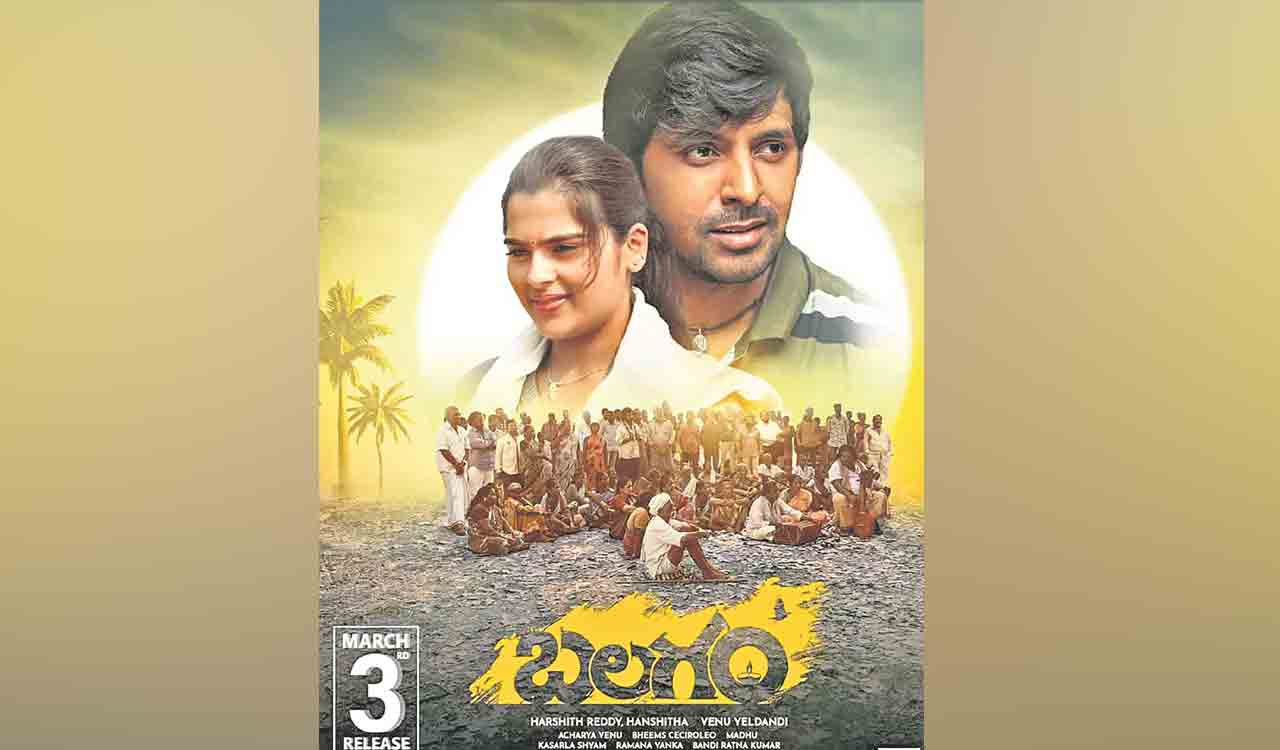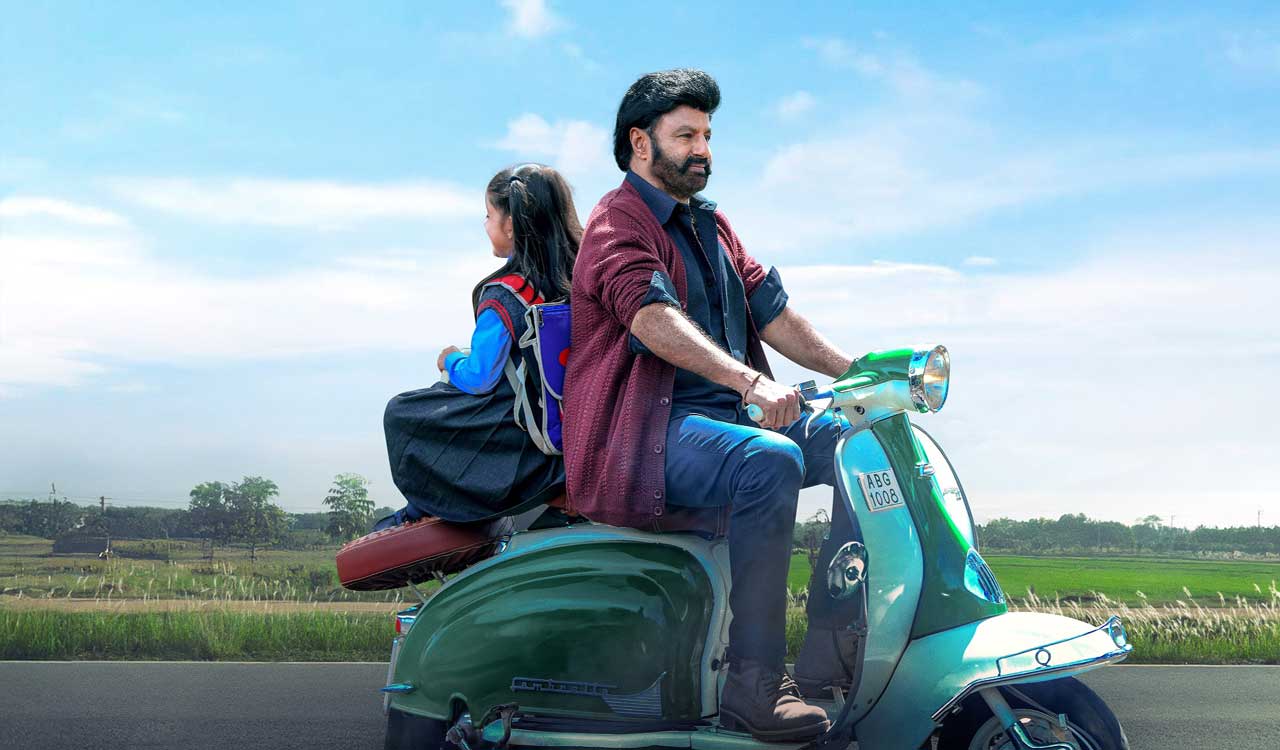Balagam: Film about forgiveness and forgetting grudges
The movie seems to be more closely related to the 2015 Kannada film Thithi, although it distinguishes out as a genuine social reflection on Telangana family relationships and culture.

By Dr. Ram Shepherd Bheenaveni
Hyderabad: The just released Telugu film “Balagam” which means “family, friends and relatives,” written and directed by Venu Yeldandi in his directorial debut. Priyadarshi Pulikonda as Sailu, Kavya Kalyanram as Sandhya, Sudhakar Reddy as Komuraiah, Jayaram as Ilaiah, Mime Madhu as Mogulaiah, Muralidhar Goud as Narayana, and Roopa as Laxmi played family members like grandson, granddaughter, grandpa, elder son, younger son, son-in-law, and daughter respectively. The movie seems to be more closely related to the 2015 Kannada film Thithi, although it distinguishes out as a genuine social reflection on Telangana family relationships and culture. It goes without saying that the film constructs a narrative about the course of traditional rural life and how individuals move within socio-cultural milieu when the human relationships broken drastically.
Also Read
With reference to Telangana rural middle-class lifestyle and lifeworld, Balagam provides a plot to comprehend and analyze how family relationships are destroying due to little egos, despite of having a lot of care, love, and compassion for each other inwardly. This is a vital point to investigate the root cause of egos and why one is unable to conquer them. Whether the egos are being taken place due to inherent human nature or the want of presentation of self in everyday life or else by the latent compelling social forces? The movie undoubtedly provides a greater grasp of how to dig inside oneself to get to a viewpoint as an audience as well as a realistic narrative for social scientists to analyze the social interactions from theoretical perspectives.
We incorrectly attribute the commercialization of products, relationships, and lives to modernity, while postmodernity was actually the perpetrator since it consistently instills an appreciation for individuality, fragmentation, and increasing rejection of grand reality. At this point, postmodernism’s trajectory has also been overrun, and we are on our way to the “post-truth world,” a far more perilous condition of affairs than has ever been witnessed in human history. The phrase “post-truth” refers to a historical dilemma with the application of truth in everyday life. In the film, Komuraiah, like any other rural innocent, has similar sort of doubt about whether his family would rejoin or not, and passed a way without knowing the truth.
Komuraiah’s cheerful interaction with the peasants and villagers, as well as his customary attire with tarpon and Chutta, indigenous cigar, and long walking stick portray him as a typical wise man, but he has been with volume of paranoid ripping heart for a conflict between sons and son-in-law. Ilaiah has a short temper and is prone to fighting with others over little matters, whereas his naïve brother Mogilaiah is a lackey in his wife’s hand. Narayana reacts quickly and seeks his own respect as son-in-law, whilst his wife Laxmi is patient and tries but fails to control her husband and siblings to establish a harmonious relationship. Sailu is a simple person who is unemployed and always surrounded by his friends, while his cross-cousin Sandhya is an educated and wants to understand each other, and a hesitant of family quarrels being a matured girl.
As a film Balagam focuses primarily on changing family relationships, social expectations of a person and a family, and the forces that rip them apart while yet driving them to stay together. In the film, the village council compelled family members to combine, but in real life, equivalent interventions by the council, caste association, youth organization, or any other group may not be found since not just family bonds, but traditional social institutions, have also been damaged due to a variety of factors in contemporary times. This is an emerging societal issue, and all villages are gradually individualizing in the same way that of urban centers.
Generally, marriage is believed to knit families together, but this film shows that Komuraiah’s death brings back his estranged daughter Lakshmi, who has been forced to be away from her family for twenty years because her husband Narayana has been at odds with his brothers-in-law. The death eventually not only reunited the divided families, but also resulted in the marriages of new couples being fixed.
Sailu’s story also demonstrates how rural educated youth are forced into massive debt in pursuit of a livelihood, as well as his numerous business failures as a result of insufficient training. Drinking alcohol for all occasions is also a major concern in the villages showed realistically in the film. Laxmi, the daughter, is the most affectionate person among all indicating the preference for females in Telangana culture.
Indigenous folk arts such as Burra Katha and Oggu Katha added a distinct flavor to the film, while lyrics performed in vernacular folklore inspired the audience with age-old wisdom. The film confirms that folk arts are still highly valued in Telangana. The story starts with Komuraiah’s death and ends with his 11th-day ceremony being offered as part of traditional rites. It’s a surprising point that the whole story centers around death and bereavement. Despite the fact that days were spent in mourning, the narrative nevertheless produced a significant amount of laughter too.
Overall, the Balagam film is a welcoming sign in many aspects, such as low budget message-oriented picture, low profiled star cast from a non-film family background, filmmaking by young professionals, upbringing and blending with local folklore, focused on middle-class family issues, and so on. Let people must welcome and offer the film as a token of love and affection one another in order to forgive and forget any grudges and to rebuild connections.
(Author is a Visiting Scholar to University of Texas Rio Grande Valley, USA.)
Related News
-
Inter student dies by suicide in Telangana college hostel
2 mins ago -
Save future of Telangana NEET PG aspirants, IMA writes to CM Revanth Reddy
50 mins ago -
Telangana techie loses Rs 4.15 lakh to online gold trading fraud
1 hour ago -
Hyderabad: Couple working as house help at doctor’s residence held for theft
2 hours ago -
Hyderabad auto driver foils attempt to kidnap young woman, five held
2 hours ago -
Haiti gang attack on journalists covering hospital reopening leaves 2 dead, several wounded
4 hours ago -
21 dead as Mozambique erupts in violence after election court ruling
4 hours ago -
Cartoon Today on December 25, 2024
11 hours ago




